One Health Approach Response Planning During COVID-19: During Action Review and Tabletop – Bangladesh
by Uzzaman M Salim1, Shirin T1*, Alamgir ASM1, Rahman M1, Mushtuq Husain M1, Divi N2, McNeil C2
1IEDCR, DGHS, Bangladesh.
2Ending Pandemics, USA.
*Corresponding author: Uzzaman M Salim , IEDCR, DGHS, Bangladesh.
Received Date: 06 November, 2023
Accepted Date: 13 November 2023
Published Date: 15 November, 2023
Citation: Uzzaman M Salim, Shirin T, Alamgir ASM, Rahman M, Mushtuq Husain M, et al. (2023) One Health Approach Response Planning During COVID-19: During Action Review and Tabletop - Bangladesh. Rep Glob Health Res 6: 175. https://doi.org/10.29011/2690-9480.100175
Abstract
From the early stages of the COVID-19 pandemic in January 2020, the Institute of Epidemiology, Disease Control and Research (IEDCR) in Bangladesh built upon its strong One Health foundation to work across sectors in the pandemic response. This case study brings to light how IEDCR employed a ‘One Health’ approach to evaluating COVID-19 pandemic response using a unique methodology, the ‘During Action Review and Table-top Exercise (DART)’. DART allowed IEDCR to review readiness and resiliency to COVID-19 from retrospective and prospective perspectives. The summary report will share the importance in taking a One Health approach to evaluate COVID-19 pandemic response. DART facilitated participant-led identification of opportunities for further transdisciplinary expert collaboration and provided a means to the government for improving understanding of challenges faced within each sector. Specifically, IEDCR the lead agency for pandemic response under Director General Health Services (DGHS), Ministry of Health and Family Welfare, Bangladesh identified needs related to strengthening of Points of Entry (POEs), multisectoral engagement, capacity building trainings (Epidemiology, Labs & Service providers), arrangements for quarantine & isolation facilities, and enhancing SARS-CoV-2 PCR testing capacity through bringing on board the PCR capacity of laboratories of Department of Health, Department of Livestock Services, Bangladesh Livestock Research Institute (BLRI), Veterinary University and other universities and institutions with molecular testing capacity.
Introduction
The benefit of a transdisciplinary approach to evaluate pandemic response, the ‘One Health’ evaluation of COVID-19 pandemic response took into consideration the roles, responsibilities, readiness and resiliency among multiple disciplinary sectors in Bangladesh. Bringing together the Departments of Health Services, Institute of Epidemiology, Disease Control and Research (IEDCR), Communicable Disease Control Unit of DGHS, IHR Team, Immunization Program, Infectious Disease Hospital in Dhaka, Dhaka and Manikgonj Medical College Hospitals, Department of Livestock Services, Bangladesh Livestock Research Institute, Chittagong Veterinary and Animal Sciences University, One Health Institute Chittagong, Forest Department, Civil Aviation, Religious Affairs Ministry, Security forces, the icddr’b and other relevant departments/sectors is an immense task.
Effective response requires understanding of challenges and strengths among and within each sector and discipline; however, often response evaluation focuses within a given field and not across fields. The DART was coordinated through ‘One Health Secretariat (OHS)’. This ‘During Action Review and Table-top Exercise (DART)’ is a new and novel approach, can be deployed to provide a prospective and retrospective analyses of multisectoral response to outbreaks. It highlights how a One Health, transdisciplinary evaluation helped IEDCR (OH Lead agency) learn the process to trigger timely response and align the sectoral coordination as and when required. It uncovered the challenges and strengths faced during COVID-19 response across and among multiple disciplines.
Background and Context
In Bangladesh, One-Health ‘conception, initiation and action’ started after the Chittagong Declaration on “One World One Health”-Bangladesh Initiative in 2008 resulting in the establishment of a the ‘One Health Bangladesh’. Chittagong Veterinary and Animal Sciences University (CVASU) took the initiative for the discussion on the “One Health” concept with experts from relevant stakeholders and partner organizations e.g.; Institute of Epidemiology, Disease Control and Research (IEDCR), Department of Livestock Services (DLS), Department of Forestry (DoF), Department of Agricultural Extension, icddr’b, Bangladesh, Bangladesh Agricultural University (BAU), Bangladesh Poribesh Andolon (BAPA), Bangabandhu Sheikh Mujib Medical University (BSMMU), International Union for Conservation of Nature (IUCN), Bangladesh, Institute of Food and Radiation Biology (IFRB, BAEC) and other relevant stakeholders from Government, UN agencies, universities, research organizations and other NGOs.
“One Health in Bangladesh”
The ‘Nipah virus (NiV) encephalitis’ large outbreak was identified in 2004, then exploration of historical samples identified cases from 2001 & 2003, in 2007 highly pathogenic ‘H5N1 Avian Influenza’ outbreak in poultry in Bangladesh and 2009-10 Influenza A H1N1 pdm09 pandemic, the ‘Human anthrax’ outbreak in almost every year in last decade brought the concerned scientist of the relevant sectors to work together on these common issues of emerging Zoonotic disease with the common strategic and intervention plan to prevent, early detect and rapid response for control of the disease outbreaks. The need for civil society ‘One Health Bangladesh’ was felt even stronger when experts realized Bangladesh is one of the densely populated countries in the world, and is one of the hot spots for emerging infectious diseases (EIDs) & Re-emerging infectious diseases (Jones et al. 2008, Nature) and need community engagement for effective response. People in the village live close to animals and disease spillover is a threat, the country faces the public health threats of emerging and re-emerging diseases, challenges of Antimicrobial Resistance (AMR), Food security and safety is vulnerable in Bangladesh, with delicate ecosystems, Arsenic in the tube-wells is a public health concern with high- level above the WHO standard.
The Main Objectives of ‘One Health Bangladesh’
- Advocacy, communication and networking (community, national, regional & global level).
- Awareness building among the key stakeholders, political leaders, and policy makers, and the government.
- Promote ‘One Health’ through programs (seminar, conference, advocacy programs, webinars and consultative workshops, share good practice & success stories one-health day celebration).
- One Health country strategic document development.
- Collaborative practices and research collaboration.
- Provide technical support to ‘One Health Secretariat (OHS)’ for initialization of OH in Bangladesh through OHS.
Figure 1. Institutional arrangement One Health Secretariat *
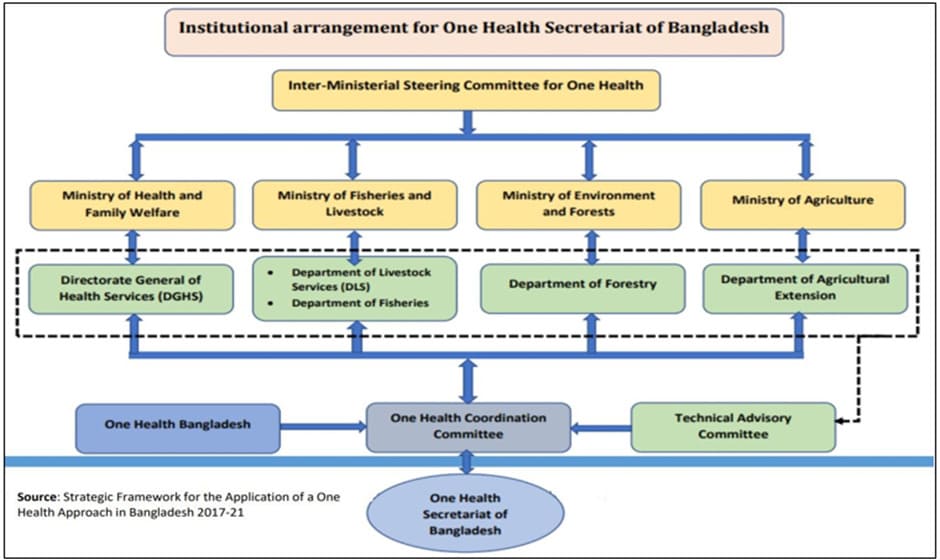
Figure 2. Timeline of One Health in Bangladesh
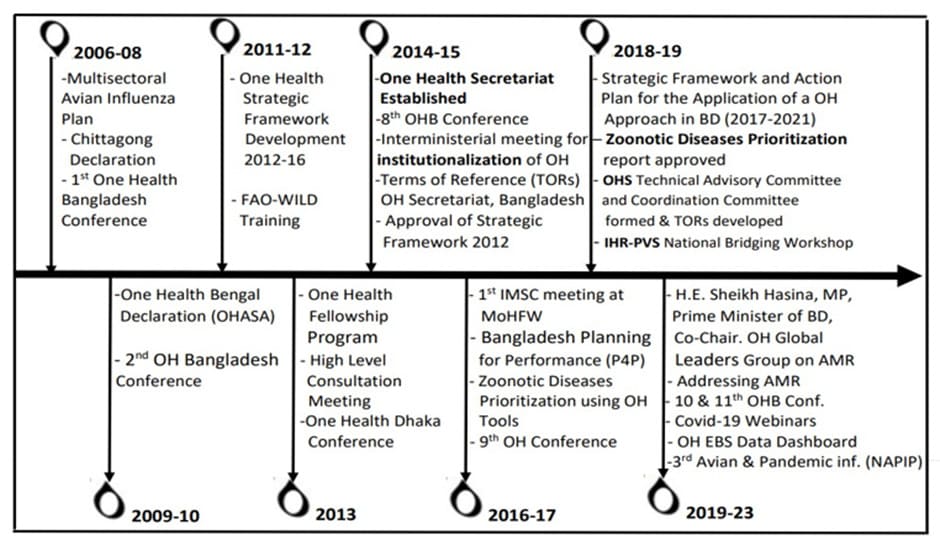
COVID-19 Situation in Bangladesh
The first confirmed COVID-19 was reported in Bangladesh on March 08, 2020 (https://www.ncbi.nlm.nih.gov/pmc/articles/PMC8516147/#bib0016). On 18 March, Bangladesh reported its first COVID-19 death (DGHS, Bangladesh).
Until 27 September 2023 Bangladesh reported 2,045,671 confirmed cases of COVID-19 with 29,477 deaths (https://covid19.who.int/region/searo/country/bd) reported. Vaccine campaigns began in a limited capacity in late January 2021. As of 15 November 2023, a total of 150,922,846 , 1st dose vaccine administered (https://dashboard.dghs.gov.bd/pages/covid19-vaccination-update.php) have been administered. While Bangladesh ranks eighth in the world in terms of population (https://www.worldometers.info/world-population/population-by-country/), at that time it ranked 31st in terms of COVID-19 prevalence and the Covid-19 impact was “-0.42” (2019-21) (https://en.wikipedia.org/wiki/List_of_countries_by_life_expectancy).
Figure 3. DGHS, Bangladesh Number of Lab Tests vs. Confirmed Cases National (Daily).
Source: DGHS Website. 06/10/2023
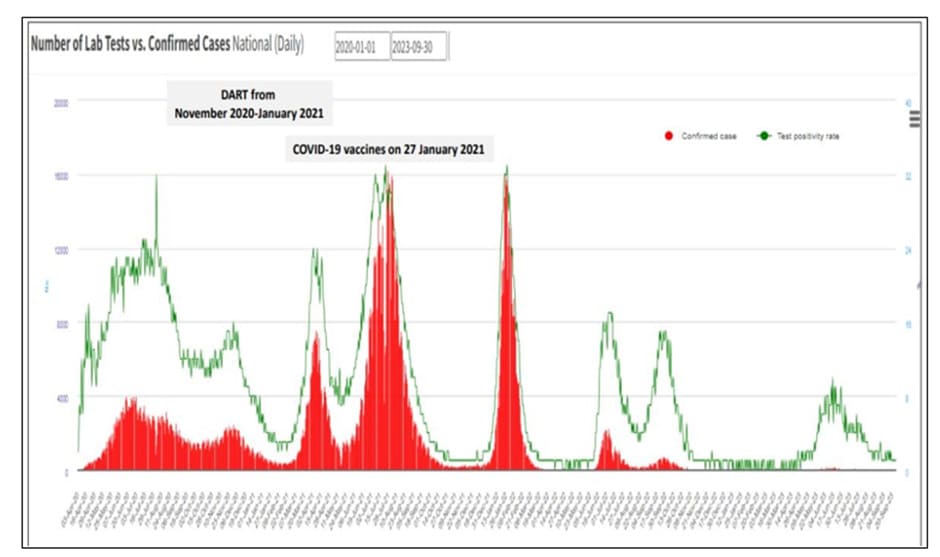
COVID-19 (http://103.247.238.92/webportal/pages/covid19.php) https://covid19.who.int/region/searo/country/bd
Copyright © 2023 MIS, DGHS Data source: HEOC & Control Room, IEDCR, DHIS2, Technical assistance by: UNICEF
Director IEDCR as Chairperson of the One Health Secretariat (OHS), Bangladesh, initiated One-health approach for coordination, cooperation and collaboration among relevant multisectoral multidisciplinary entities. During the One-health response initially started with awareness building, information sharing through multiple webinars (around 10), which was participated by nationally and internationally renowned One-health scientists. Later on Laboratory networking (Human Health and Animal Health Sectors) started through strengthening the diagnostic capacity of the country through involvement of the PCR labs of Department of Livestock and Animal Health University in the country. A group of veterinarians’ lab specialist who were directly involved with COVID 19 (SARS-CoV-2) diagnosis provided technical support to other COVID-labs for their capacity building and quality control. The veterinarians and veterinary epidemiologists were involved in different COVID-19 study.
Human health sector surveillance activities were primarily done by the Health Department but there were scientific engagement with One-Health partners too. Department of Communicable Disease control, DGHS was involved in Point of Entry (POEs) coordination mechanism for control of COVID-19 involving other relevant sectors (e.g.; Civil Aviation, Immigration. Police, Security services, Ministry of Religious affairs) and training for capacity building of the healthcare service providers. The National Security forces was also involved in Isolation and Quarantines services and initial zonal lockdown approach; Ministry of Religious affairs was involved for religious messages and proper and safe burial services of the Covid cases death bodies. Other sectors including IT sector, commerce ministry (food and other support during lockdown) of the Government were involved to provide logistic support. The During Action Review and Tabletop (DART) exercise was conducted through OHS to identify opportunities for collaboration and coordination using a One Health approach response. This could also lead to rapid improvements in readiness and multisectoral response. It could also align the sectoral coordination as and when required, recognize the challenges and strengths faced during COVID-19 response, Lab diagnosis and logistics is critical for identifying areas for improvement and necessary next steps.
Methodology
The During Action Review and Tabletop (DART) exercise methodology1 was conducted from November 2020-January 2021 using a participatory approach to assess COVID-19 response across multiple sectors and disciplines: Case Management & Countermeasures, Travel/ Point of Entry, Emergency Response and Communication, Epidemiology & Laboratory, Animal Health, and Overall Coordination. DART begins with a review of the response to date to allow for retrospective evaluation of readiness which informs the development of scenarios for an exercise to test resiliency to future challenges. DART empowers participants to identify their priority needs and gaps through using participant-led analysis techniques. The multiplayer, transdisciplinary design of DART scenarios is uniquely suited for multisectoral exercises. Unique exercise scenarios and information flow are designed to mimic real life scenarios. For example, Livestock ministry officials only receive data about animal health, while point of entry officials tackles scenarios at an airport and epidemiology and laboratory address scenarios focusing only public health. Participants are advised to share information only if they would do so during a real-life situation, allowing for assessment of information sharing.
The DART was coordinated through ‘One Health Secretariat (OHS)’. This ‘During Action Review and Table-top Exercise (DART)’ is a new and novel approach, can be deployed to provide a prospective and retrospective analyses of multisectoral response to outbreaks; can help understand how a One Health, transdisciplinary evaluation helped IEDCR (OH Lead agency) learn the process to trigger timely response and align the sectoral coordination as and when required, and recognize the challenges and strengths faced during COVID-19 response across and among multiple disciplines.
In order to conduct a transdisciplinary evaluation of COVID-19 response in Bangladesh, IEDCR (Public Health Sector Government Agency) first identified the following key response roles to participate in the DART exercises: Epidemiology and Surveillance, Behaviour and Risk Communication, and Vaccines and Mitigation Measures. Expert participants who were familiar with the daily activities of these roles were selected as participants.
DART Conducted
The DART was conducted in a series of 5 steps by a team led by IEDCR.
STEP 1. During Action Review
In coordination with collaborators at Ending Pandemics, USA and Sandia National Laboratories, an initial hour-long questionnaire was developed in the each of these critical response roles to collect information about what was going well so far in the response, what needed improvement in the response to date, and what types of future scenarios might complicate the pandemic response activities. Responses were collected and organized through a facilitated, two-hour session with participants from across the different disciplines who discussed strengths and gaps in the response to date. Participants also identified the most concerning future scenarios for how the pandemic may unfold to inform the Tabletop Exercise Design (Step 2).
Figure 4: STEP 1. During Action Review
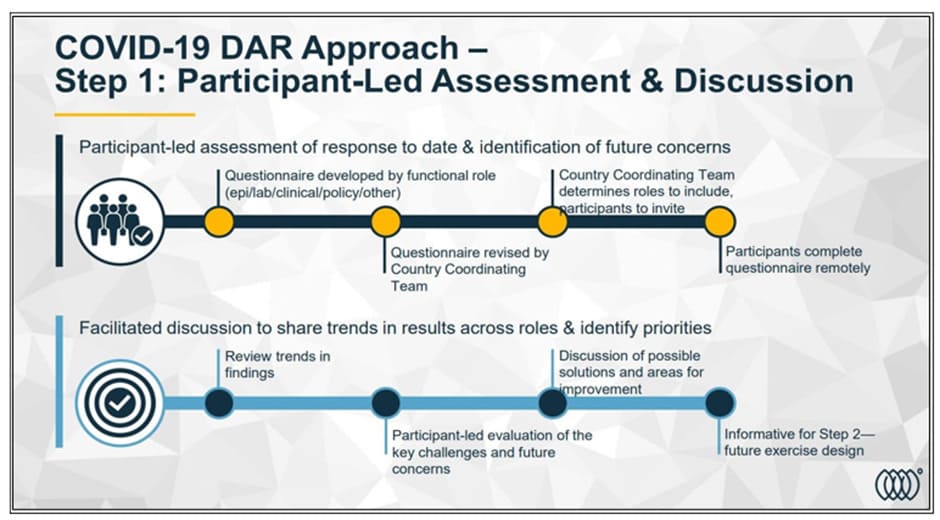
(Source: Ending Pandemics, USA) [1]
STEP 2: Tabletop Exercise (TTX) Design
Following Step 1, IEDCR, Ending Pandemics and Sandia National Laboratories met to conduct a Concept and Objectives meeting to define objectives for the TTX based on data collected in Step 1 regarding critical gaps in response capabilities and future scenarios of concern. Based on input from Step 1, it was determined that this transdisciplinary TTX should focus on the following response roles: Epidemiologist, Laboratorian, Animal Health, Emergency Responder & Communicator, Airport Response Team/Point of Entry. Scenarios were written to explore three futures scenarios: (1) January 2020: No vaccine, no new treatments, Nipah season, concurrent FMD outbreak; (2) July 2021: Dengue season, Post-Eid festival (Muslim Religious event), limited supply of vaccine but distribution challenges, floods; (3) June 2024: Resurgence of a new strain that is not covered by vaccine. These scenarios also reviewed capability needs identified during Step 1. Between each phase, participants answered assessment questions: “For what did you feel most prepared?”, “For what did you feel least prepared?” ,“What actions could be taken today to strengthen your ability to respond to this scenario?”, and “Did the scenario highlight or bring to your mind any other potential scenarios to plan for in the future?”
STEP 3: TTX Conducted in STARTx
The multiplayer, multi-scenario TTXs were conducted remotely online using the Scenario-based Tool for Assessing Readiness through Tabletop Exercises (STARTx ) .2 TTXs were designed to be completed in less than 90 minutes asynchronously over one week to allow for those actively engaged in a response to complete when available to do so. Participants were given scenarios unique to their roles but also provided opportunities to communicate through STARTx with other disciplines. All participants were asked to answer questions as they would do during the actual response, based on current plans and protocols.
STEP 4: TTX After Action Review (TTX AAR)
Following completion of the TTX, participants were provided a draft TTX, After Action Review (AAR) report downloaded from STARTx to share each role-based scenario and responses from each participant. Sharing the AAR allowed all participants to have a common operating picture since they were each playing pieces of the scenario unique to their roles. During the AAR discussion, participants identified overarching needs and recommendations for strengthening capabilities to improve future resiliency and readiness.
STEP 5: COMPREHENSIVE ASSESSMENT REPORT
Participant findings were collated into a comprehensive assessment report. The report was disseminated back to participants to review and give necessary inputs to finalize. Specific questions related to the capabilities and activities conducted by the following functional roles: Epidemiology & Laboratory, Case Management & Countermeasures, Emergency Response and Communication, Animal Health, Travel/ Point of Entry and Overall Coordination. An evaluation report was sent to all participants after all steps were completed to review the effectiveness of this approach.
The report was shared with the country coordinating team to review these next steps and, as appropriate, identify specific action plans (with responsible parties, timelines) to address these needs.
Figure 5: During Action Review and Tabletop Exercise Features and Steps
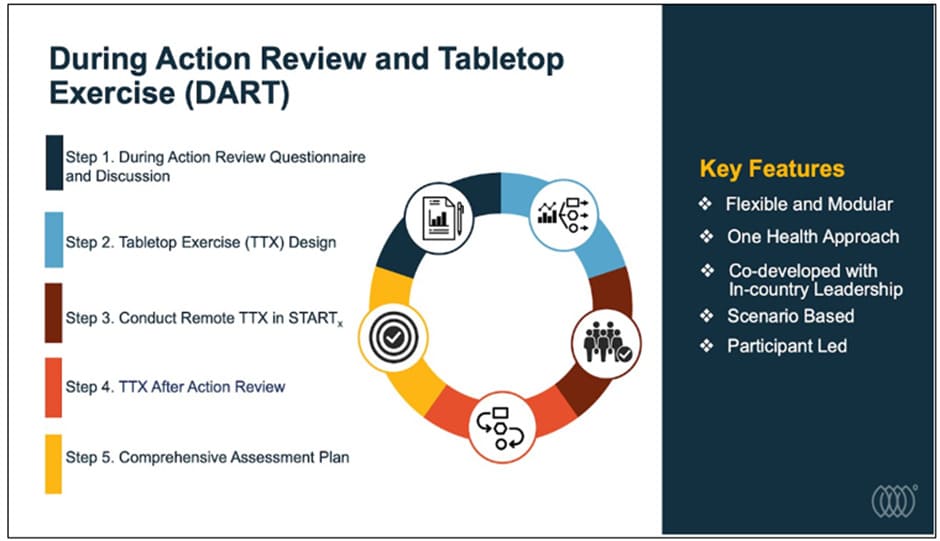
Source: Ending Pandemics, USA)
Results
The DART brought together again the One-health community to identify the gaps and challenges and even more the opportunities together and bring about just changes as per requirement and resources available. The Resource persons-pool got bigger to response and take advantages of the opportunity. ‘Intersectoral coordination’ was strengthen and whole of the Government system was involved. It (DART) helped us identify the obstacles and changes required to achieve better and timely response.
The technical Process and collaborative achievements are a lesson learned for quickly organizing response mechanism and time-interval review for the necessary correction for the future EIDs to come.
Table 1: Key Strengths Identified
|
Key Strengths in One Health Response
|
Through DART, during the initial steps of DART, participants identified the following scenarios to include in the TTX to test for further future challenges in the COVID-19 response. The participants identified initial gaps and challenges requiring timely attention as well as critical next steps to achieve the successful multisectoral coordination and collaboration during COVID-19 response (Table 2). After identification through DART in Feb 2021, the Government of the People's Republic of Bangladesh put more attention on key issues needing attention and successfully achieved most of the recommendations put forward. For example, next steps included aspects of strengthening community response and building community trust; bolstering laboratory capacity and training; hospital improvements—such as increasing overall hospital capacity, creating dedicated COVID areas, developing protocols and providing new trainings; and, building sustainable response capacity through actions such as cross-sector surge capacity rostering. In One Health, adding in wildlife health surveillance elements and supporting the role of Field Epidemiology Training Program (FETP) were recommended. For Logistics, needs for waste stream management and decreasing reliance on foreign suppliers was advised. Improving risk communication among professionals and with the people was also encouraged. At the borders and airports, recommendations included additional staff training for those without health backgrounds and continuing airport surveillance.
Table 2: Priority Next Steps from Tabletop Exercise ‘After Action Review’
|
Key Areas to Improve |
Recommended Next Steps |
|
Strengthening Community Response |
|
|
Laboratories |
|
|
|
|
Hospitals |
|
|
Building and Sustaining Response Capacity |
|
|
One Health and Surveillance |
|
|
Logistics/Response |
|
|
Communications |
|
|
Travel/Airport |
|
Discussion
Based on post-DART surveys, DART successfully provided IEDCR a unique approach designed to evaluate multisectoral, transdisciplinary response. This approach has since been replicated in two other countries for COVID-19 and could also be used for other ongoing zoonotic outbreaks in Bangladesh and other countries. DART’s design allowed for each group to work within their usual roles during response and gave opportunities for learning about other roles and responsibilities. A survey questionnaire was sent to all participants several months after the DART was completed to evaluate this approach; half of the 26 participants responded. All participants agreed or strongly agree to the statement that the DART “helped us review strengths and gaps in multisectoral coordination and collaboration during COVID-19 response” and almost all (2 were neutral) agreed or strongly agreed that DART “helped us identify ways to improve the One Health approach to COVID-19 response.” All participants also agreed or strongly agreed that the DART retrospective review (Step 1) identified challenges in current response and priority concerns about the response ahead and, except for one “neutral,” all also stated the TTX scenarios “were realistic and/or reflected our concerns about potential future complications in responding.”
In Bangladesh DART exercise helped to identify and overcome the challenges that requires ongoing commitment to interdisciplinary collaboration, improved infrastructure, better data-sharing mechanisms, and the development of policies and strategies that facilitate a holistic response to pandemics. The Government decided to revise and update the “ Strategic framework and Action Plan for the application of One Health approach in Bangladesh 2017–21’’ and built-on ‘Lesson learned from Pandemic’ with stronger intersectoral coordination through ‘One Health approach’. The revised version will include costed plan of activities for the OH line departments, and capacity building of the OH-workforce. It was also documented that the use of ‘DART participatory One Health approach’ methodology is useful for the pandemic preparedness and response in future to assess COVID-19 response across multiple sectors and disciplines. Strengthening of the ‘One Health Secretariat’ is also important to monitor the accomplishment of recommendations and bring in the civil society for stronger ‘One Health’ advocacy role at all levels.
Conclusions
Effective response to emerging zoonoses requires transdisciplinary coordination in response. However, during a response, coordination and communication can be difficult as each sector is focusing on a specific task or role. Taking time to evaluate a response during a pandemic can provide valuable insights into how to strengthen the current response and build resiliency to what may come next. The DART brought together experts from different sectors and disciplines to look back to identify strengths and gaps in the response and to identify ways to work together to build resiliency to future scenarios. Assessing the effectiveness of the One Health approach during the pandemic and incorporating lessons learned into future response planning through DART can be helpful for the evaluation mechanisms and practice.
Limitations
Due to the pandemic ‘DART’ was conducted virtually, in-person meeting were challenging as the government declared ‘to work from home’. Coordinating diverse groups and their actions in real-time was complex and challenging, especially during a rapidly evolving pandemic. Perhaps more departments and sectors which were identified eventually over the time of pandemic will be required to be included for future successful DART outcomes.
Acknowledgements
We would like to acknowledge Mark Smolinski and Nomita Divi from Ending Pandemics, Ann Hammer MS and Matthew Sumner PhD, Sandia National Laboratories for their expertise in development of the role-specific DART questionnaires; Jessica Rowland MS, Helene Walker, Alexis Joiner MS and Vibeke Halkjaer-Knudsen PhD, Sandia National Laboratories Global Chemical and Biological Security Group for their contributions to DART.
References
- McNeil C, Divi N, Smolinski MS (2023). Looking Ahead in the Rearview Mirror: During Action Review and Tabletop (DART) to Strengthen Health Emergency Readiness and Resiliency. Disaster Medicine and Public Health Preparedness 17: E355.
- Chamberlin M, Okunogbe A, Moore M, Abir M (2015) “Intra-Action Report - A Dynamic Tool for Emergency Managers and Policymakers: A Proof of Concept and Illustrative Application to the 2014–2015 Ebola Crisis”.
- Food and Agriculture Organization of the United Nations (2021) Good Emergency Management Practices, Third Edition.
- Ndriko Mayigane L,de Vázquez CC, Vente C, Charles D, Copper FA, et al. (2020) “The Necessity for Intra-Action Reviews during the COVID-19 Pandemic,” The Lancet Global Health 8: e1451-52.
- Skryabina E, Reedy G, Amlôt R, Jaye P, Riley P (2017) What is the value of health emergency exercises: A review study. International Journal of Disaster Risk Reduction 21: 274-283.
- World Health Organization (2020) Guidance for conducting a country COVID-19 Intra-Action Review.
- 7. World Health Organization (2017) WHO Simulation Manual.
- World Organization for Animal Health (2022) Guidelines for Simulation Exercises.
Bangladesh One Health:
- One Health Zoonotic Disease Prioritization for Multisectoral Engagement in Bangladesh.
- Isha Berry I, Rahman M, Sabrina Flora M, Shirin T, Alamgir ASM, et al. (2022) Seasonality of influenza and coseasonality with avian influenza in Bangladesh, 2010–19: a retrospective, time-series analysis. Lancet Global Health.
- Strategic framework for One Health approach to infectious diseases in Bangladesh 2012.
- *Strategic framework and Action Plan for the application of One Health approach in Bangladesh 2017-2021.
- Scenario-Based Tool for Assessing Readiness Through Tabletop Exercises. STARTx.
© by the Authors & Gavin Publishers. This is an Open Access Journal Article Published Under Attribution-Share Alike CC BY-SA: Creative Commons Attribution-Share Alike 4.0 International License. Read More About Open Access Policy.